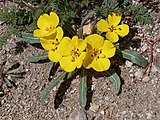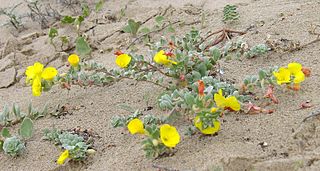
Camissoniopsis cheiranthifolia, the beach suncup or beach evening primrose, is a species of the evening primrose family and is native to open dunes and sandy soils of coastal California, Baja California and Oregon.

Ornithostaphylos is a monotypic plant genus which contains the single species Ornithostaphylos oppositifolia, commonly known as the Baja California birdbush or Baja California manzanita. A large, evergreen shrub in the heather family, this species is near-endemic to northwestern Baja California, with a small population just north of the border in San Ysidro, California. It produces a much-branched inflorescence of white, urn-shaped flowers, and has leathery leaves that appear opposite or in whorls. These characteristics separate it from its close relatives in the region, which include manzanitas (Arctostaphylos), summer holly (Comarostaphylis) and mission manzanita (Xylococcus).
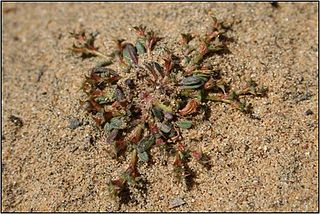
Chorizanthe orcuttiana is a rare small annual plant in the buckwheat family, Polygonaceae. It is known commonly as Orcutt's spineflower or the San Diego spineflower, and it is endemic to San Diego County, California. The plant is diminutive, and a hand-lens is necessary for proper identification. The plant is very sensitive to temperature and precipitation, and under drought or hot conditions the seeds will not germinate or survive. The plant is visible anywhere from February through July during good rain year, but most years the plant is only visible from April to June. Each minute flower yields one seed.
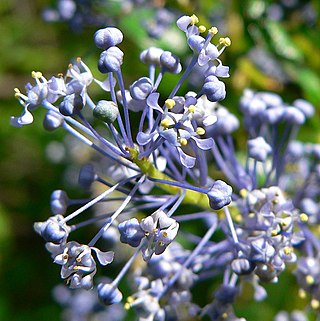
Ceanothus cyaneus is a species of flowering shrub in the genus Ceanothus known commonly as the San Diego buckbrush and Lakeside ceanothus. This species is found in the Peninsular Ranges of San Diego County, California, and known from one occurrence in Baja California. It is characterized by brilliant blue flowers, glossy green foliage, and is regarded as one of the most beautiful members of the genus.
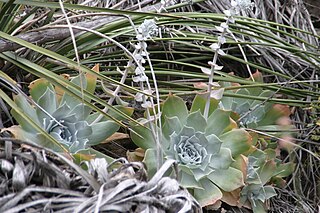
Dudleya pulverulenta is a species of perennial succulent plant known by the common names chalk lettuce, chalk dudleya, and chalk liveforever. It is one of the largest Dudleya, with a silvery, waxy rosette that may greatly contrast with its habitat. It is also regarded as one of the most distinctive members of the Dudleya, with one of the most specialized inflorescences in the genus, adapted to hummingbird pollination through its red pendent flowers, the longest corolla, and the highest nectar output. Dudleya pulverulenta has the largest range of all Dudleya, over 1,000 kilometres (620 mi), being found from southern Monterey County in California to the Sierra de San Borja in southern Baja California. It is closely related to Dudleya arizonica, a smaller desert species that tends to lack the specialized floral traits, and Dudleya anthonyi, which differs in a few morphological traits and is restricted to the San Quintín Volcanic Field.

Dudleya brevifolia, is a rare succulent plant known by the common name short-leaved liveforever, short-leaved dudleya or rarely the Del Mar Hasseanthus. It is an edaphic endemic that only grows on Lindavista formation marine terraces, on surfaces with ironstone nodules. The leaves are deciduous, and disappear after the inflorescence develops. The small white flowers are star-shaped with a yellow center. After flowering, any above ground trace of the plant will disappear, and it survives under the earth with a starch-rich subterranean caudex. Dudleya brevifolia is only found on coastal mesas along a small strip of coast in San Diego County, California.

Eulobus californicus, is a species of flowering plant in the evening primrose family known by the common name California suncup. It is native to California, Arizona, and adjacent northwestern Mexico, where it grows in scrub, chaparral, and desert plant communities.

Camissoniopsis micrantha is a species of flowering plant in the evening primrose family known by the common names miniature suncup or small evening primrose. This is a small, hairy annual herb producing a basal rosette of leaves. It is characterized by small yellow flowers with petals less than 5 millimeters long. The flowers dry to a reddish color as they close. This species is found in Arizona and California in the United States, along with Baja California in Mexico. It grows in sandy areas in a number of habitats, from beaches to inland slopes. It is the smallest member of the genus Camissoniopsis.

Hooveria parviflora is a species of perennial herb in the Agave/Yucca subfamily known by the common name smallflower soap plant. It is a monocot, native to coastal southern California and Baja California, where it is a member of the coastal sage scrub flora. It resembles a smaller version of Chlorogalum pomeridianum, with wavy leaves and white flowers that open during the day.
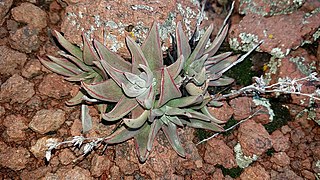
Dudleya abramsii is a species complex of succulent plants native to California and parts of Baja California. There are numerous subspecies, some critically endangered, with varying habits and lifestyles, but most often characterized by a smaller size, yellow flowers, and an affinity for rocky habitats. The subspecies may be polyphyletic.

Dudleya variegata is a deciduous succulent plant in the family Crassulaceae known by the common names variegated liveforever, variegated dudleya or rarely San Diego Hasseanthus. A cryptic plant that survives part of the year dormant underground from starch reserves in a corm, after sufficient rainfall, leaves will emerge, soon giving way to small inflorescences with yellow star-shaped flowers. It is native to Baja California and adjacent San Diego County in California, where it grows in several habitat types, including chaparral and vernal pools.

Ribes canthariforme is a rare species of currant commonly known as the Moreno currant. It is characterized by pink to red flowers, a dense inflorescence, and a lack of nodal spines. A little-known endemic to the mountains of San Diego County, it is usually found growing the shade of massive boulders in the chaparral. Although the rarity and small numbers of this plant is a conservation concern, it is usually found in remote areas and is well hidden enough to be safe from most threats.

Stemodia durantifolia is a species of flowering plant in the plantain family commonly known as the whitewoolly twintip and purple stemodia. Stemodia durantifolia is native to the Americas, including Chile, Mexico, Texas, and the deserts of California and Arizona, and is often found in riparian habitats, preferring wet sand and rocks. It is a perennial herb producing a hairy, glandular, erect stem 10–100 cm (3.9–39.4 in) tall, with the toothed lance-shaped leaves found in pairs or triplets, attached to the stem with clasping bases. The inflorescence is a raceme of violet flowers, with each corolla held in a calyx of hairy, pointed sepals, and can often be found in bloom year-round. Although globally at low risk of extinction, Stemodia durantifolia is imperiled in California due to its rarity and threats from development.

Dudleya attenuata is a species of perennial succulent plant known by the common name taper-tip liveforever, native to Baja California and a small portion of California. A rosette-forming leaf succulent, it has narrow pencil shaped leaves that can often be found covered in a white epicuticular wax. The thin, sprawling stems branch to form the clusters of rosettes, with plants creating a "clump" up to 40 cm wide. The small flowers are white or yellow, with 5 spreading petals. It is a diverse, variable species that extends from the southernmost coast of San Diego County to an area slightly north of the Vizcaino Desert, hybridizing with many other species of Dudleya in its range. Some plants with white or pinkish flowers were referred to as Orcutt's liveforever, referring to a former subspecies split on the basis of the flower color.

Dudleya anomala is a rare species of succulent plant in the family Crassulaceae commonly known as the Todos Santos liveforever. With a dense, cushion-forming habit, this leaf succulent is characterized by elongated stems, slightly sticky leaves, and bell-shaped flowers with white, spreading petals. This species is native to Baja California, Mexico, and is found primarily on islands and one coastal locality.
Dudleya formosa, known by the common name La Misión liveforever, is a species of perennial succulent plant endemic to the Guadalupe Valley in Baja California. It is characterized by bright green leaves, red floral stems, and pink flowers.
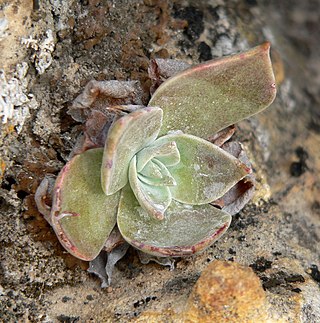
Dudleya arizonica is a species of perennial succulent plant commonly known as the Arizona chalk dudleya and the Arizona liveforever. A member of the genus Dudleya, this species is characterized by long, red flowers that adorn a waxy rosette of succulent leaves. It resembles a reduced desert form of the more coastal chalk dudleya, Dudleya pulverulenta, but differs in its smaller stature, lower number of leaves, and orientation of the flowers. Native to the southwestern United States and northwestern Mexico, it is widespread in range, but is primarily found in scattered, widely separated localities. It can be found as far west as coastal Ensenada to the desolate desert ranges of Nevada. It is one of two species of Dudleya that occur in Arizona, the other being Dudleya saxosa subsp. collomiae, and is the only species on mainland Mexico and in Utah.
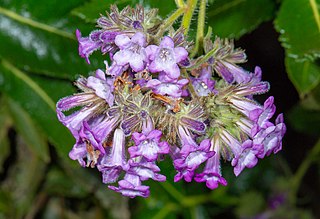
Eriodictyon sessilifolium, known by the common names Baja California yerba santa, sessile-leaved yerba santa or sessileleaf yerba santa is a perennial shrub in the Boraginaceae family, near-endemic to Baja California but also rarely found in the southern California, in a locality near Poway.

Convolvulus simulans is a species of annual plant in the morning glory family known as the small-flowered morning-glory and small-flowered bindweed. It is an inconspicuous vining plant that is characterized by tiny pale pink or pale blue bell-shaped flowers. It is typically restricted to clay and serpentine substrates in annual grassland, coastal sage scrub and chaparral habitats. This species is native to Arizona, California, and Baja California. Some taxonomies place this species under Convolvulus equitans.
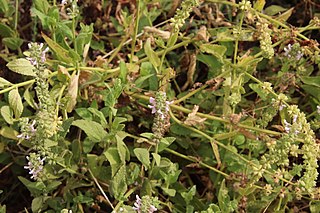
Stachys stebbinsii is a species of perennial herb in the mint family commonly known as Stebbins' hedgenettle. This plant is characterized by a musky aroma, flowers with large lower lips, and glandular hairs that densely cover the stems. S. stebbinsii is native to California and northwestern Baja California. It is usually found growing in moist places in a wide variety of habitats including disturbed areas, chaparral, coastal sage scrub and mountains.





